 | –≠–ª–µ–∫—Ç—Ä–æ–Ω–Ω—ã–π –∫–æ–º–ø–æ–Ω–µ–Ω—Ç: LZ2316AR | –°–∫–∞—á–∞—Ç—å:  PDF PDF  ZIP ZIP |
Document Outline
- ˛ˇ
- ˛ˇ
- ˛ˇ
- ˛ˇ
- ˛ˇ
- ˛ˇ
- ˛ˇ
- ˛ˇ
- ˛ˇ
- ˛ˇ
- ˛ˇ
- ˛ˇ
- ˛ˇ
- ˛ˇ
- ˛ˇ
- ˛ˇ
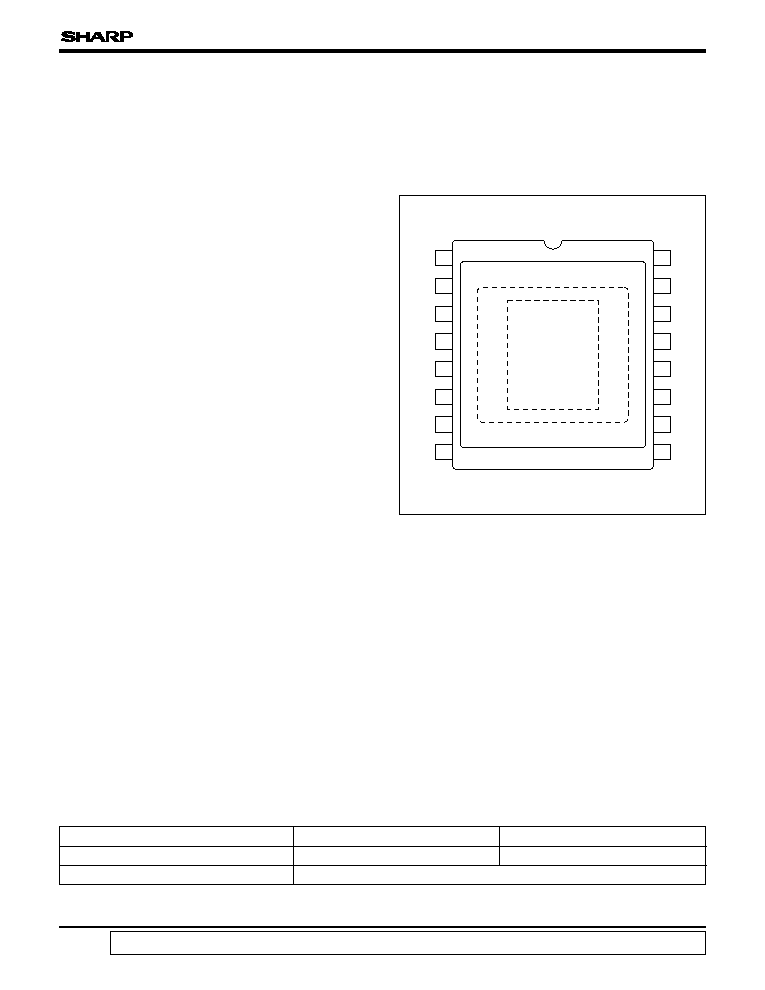
In the absence of confirmation by device specification sheets, SHARP takes no responsibility for any defects that may occur in equipment using any SHARP devices shown in
catalogs, data books, etc. Contact SHARP in order to obtain the latest device specification sheets before using any SHARP device.
1
DESCRIPTION
The LZ2315A/LZ2316AR are 1/3-type (6.0 mm)
solid-state image sensors that consist of PN photo-
diodes and CCDs (charge-coupled devices) driven
by dual-power-supply. With approximately 270 000
pixels (542 horizontal x 492 vertical), the sensor
provides a stable high-resolution color (LZ2315A)/
B/W (LZ2316AR) normal or mirror image.
FEATURES
∑ Number of effective pixels : 512 (H) x 492 (V)
∑ Number of optical black pixels
≠ Horizontal : 2 front and 28 rear
∑ Pixel pitch : 9.6 µm (H) x 7.5 µm (V)
∑ Mg, G, Cy, and Ye complementary color filters
(For LZ2315A)
∑ Low fixed-pattern noise and lag
∑ No burn-in and no image distortion
∑ Blooming suppression structure
∑ Built-in output amplifier
∑ Built-in pulse mix circuit
∑ Built-in overflow drain voltage circuit and reset
gate voltage circuit
∑ Variable electronic shutter (1/60 to 1/10 000 s)
∑ Normal or mirror image output available from
common output pin
∑ Compatible with NTSC standard (LZ2315A)/
EIA standard (LZ2316AR)
∑ Package :
16-pin shrink-pitch WDIP [Ceramic]
(WDIP016-N-0500C)
Row space : 12.70 mm
PIN CONNECTIONS
PRECAUTIONS
∑ The exit pupil position of lens should be more
than 25 mm (LZ2315A)/20 mm (LZ2316AR) from
the top surface of the CCD.
∑ Refer to "PRECAUTIONS FOR CCD AREA
SENSORS" for details.
LZ2315A/LZ2316AR
LZ2315A/
LZ2316AR
Dual-power-supply (5 V/12 V) Operation
1/3-type CCD Area Sensors with 270 k Pixels
1
ÿ
RS
2
RD
3
GND
4
OS
5
OD
6
ÿ
H2B
7
ÿ
H2
8
16
15
14
13
12
11
10
9
ÿ
H1B
T
1
OFD
ÿ
TG
ÿ
V2
ÿ
V1
ÿ
V4
ÿ
V3
ÿ
H1
16-PIN SHRINK-PITCH WDIP
TOP VIEW
(WDIP016-N-0500C)
Characteristics
TV standard
LZ2316AR
EIA standard (B/W)
LZ2315A
NTSC standard (Color)
Refer to each following specification.
COMPARISON TABLE

LZ2315A/LZ2316AR
2
PIN DESCRIPTION
ABSOLUTE MAXIMUM RATINGS
(T
A
= +25 ∞C)
SYMBOL
PIN NAME
RD
Reset transistor drain
OD
Output transistor drain
OS
Output signals
ÿ
RS
Reset transistor clock
ÿ
V1
, ÿ
V2
, ÿ
V3
, ÿ
V4
Vertical shift register clock
ÿ
H1
, ÿ
H2
, ÿ
H1B
, ÿ
H2B
Horizontal shift register clock
ÿ
TG
Transfer gate clock
OFD
Overflow drain
GND
Ground
T
1
Test pin
PARAMETER
SYMBOL
RATING
UNIT
Output transistor drain voltage
V
OD
0 to +15
V
Reset transistor drain voltage
V
RD
0 to +15
V
Overflow drain voltage
V
OFD
Internal output
V
Test pin, T
1
V
T1
0 to +15
V
Reset gate clock voltage
V
ÿRS
Internal output
V
Vertical shift register clock voltage
V
ÿV
0 to +7.5
V
Horizontal shift register clock voltage
V
ÿH
≠0.3 to +7.5
V
Transfer gate clock voltage
V
ÿTG
≠0.3 to +15
V
Storage temperature
T
STG
≠40 to +85
∞C
Ambient operating temperature
T
OPR
≠20 to +70
∞C
2
1
NOTE
NOTES :
1. ÿ
RS
, OFD : Use the circuit parameter indicated in "SYSTEM CONFIGURATION
EXAMPLE", and do not connect to DC voltage directly. When not using electronic shutter,
connect OFD to GND through a 0.1 µF capacitor and a 1 M$ resistor.
2. ÿ
V1
-ÿ
V4
: Input the clock through a 0.1 µF capacitor.
3. ÿ
TG
: Use the circuit parameter indicated in "SYSTEM CONFIGURATION EXAMPLE".
NOTES :
1. Do not connect to DC voltage directly. When OFD is connected to GND, connect V
OD
to GND. Overflow drain clock is
applied below 13 Vp-p.
2. Do not connect to DC voltage directly. When ÿ
RS
is connected to GND, connect V
OD
to GND. Reset gate clock is
applied below 8 Vp-p.
1
3
2
1
NOTE
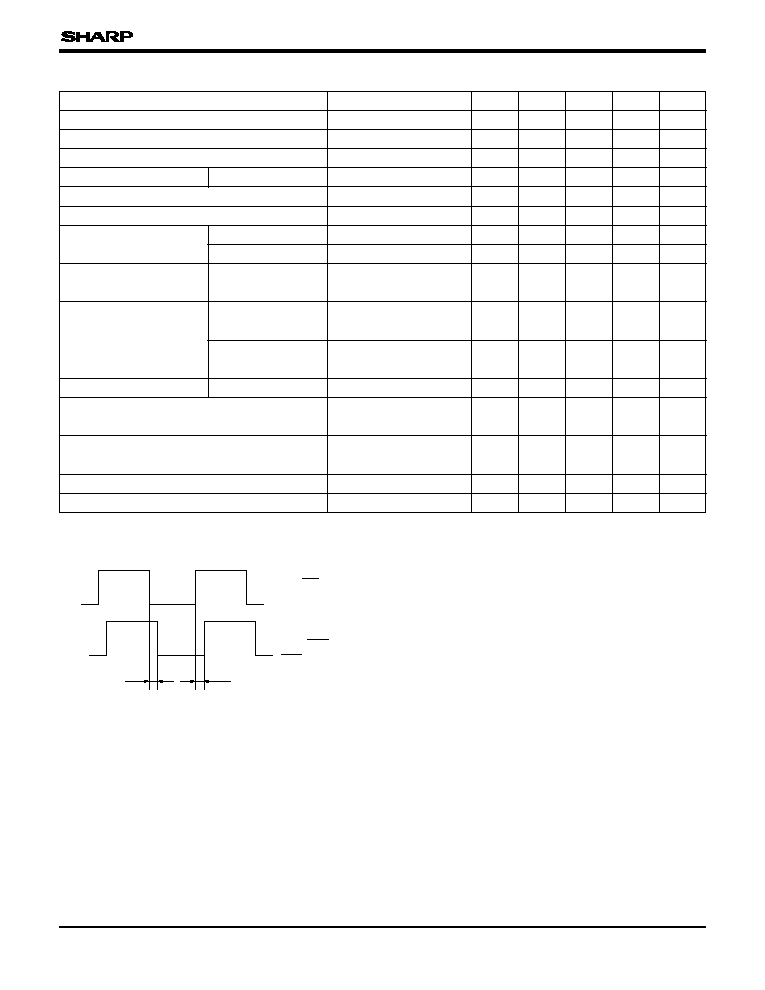
3
LZ2315A/LZ2316AR
RECOMMENDED OPERATING CONDITIONS
PARAMETER
SYMBOL
MIN.
TYP.
MAX.
UNIT
NOTE
Ambient operating temperature
T
OPR
25.0
∞C
Output transistor drain voltage
V
OD
12.0
12.5
13.0
V
Reset transistor drain voltage
V
RD
V
OD
V
Ground
GND
0.0
V
Test pin, T
1
V
T1
V
OD
V
Horizontal shift register
clock
LOW level
V
ÿH1L
, V
ÿH2L
V
ÿH1BL
, V
ÿH2BL
≠0.05
0.0
0.05
V
HIGH level
V
ÿH1H
, V
ÿH2H
V
ÿH1BH
, V
ÿH2BH
4.7
5.0
5.5
V
Reset gate clock
p-p level
V
ÿRS
4.5
Vertical shift register clock frequency
f
ÿV1
, f
ÿV2
f
ÿV3
, f
ÿV4
15.73
kHz
Horizontal shift register clock frequency
f
ÿH1
, f
ÿH2
f
ÿH1B
, f
ÿH2B
9.53
MHz
Reset gate clock frequency
f
ÿRS
9.53
MHz
1
V
13.0
12.5
12.0
V
ÿOFD
Overflow drain clock
V
0.05
0.0
≠0.05
V
ÿTGL
Transfer gate clock
LOW level
HIGH level
V
ÿTGH
12.0
12.5
13.0
V
p-p level
Vertical shift register
clock
V
ÿV1
, V
ÿV2
V
ÿV3
, V
ÿV4
4.7
5.0
5.5
V
1
p-p level
5.0
5.5
V
1
2
ns
18.0
10.0
5.0
tw
1
, tw
2
Horizontal shift register clock phase
NOTES :
1. Use the circuit parameter indicated in "SYSTEM CONFIGURATION EXAMPLE", and do not connect to DC voltage directly.
2.
* To apply power, first connect GND and then turn on V
OD
and then turn on other powers and pulses. Do not connect the
device to or disconnect it from the plug socket while power is being applied.
ÿ
H1
, ÿ
H2
ÿ
H1B
, ÿ
H2B
: Normal image output mode
ÿ
H1B
, ÿ
H2B
: Mirror image output mode
tw
1
tw
2

LZ2315A/LZ2316AR
4
CHARACTERISTICS FOR LZ2315A
(Drive method : Field accumulation)
(T
A
= +25 ∞C, Operating conditions : The typical values specified in "RECOMMENDED OPERATING CONDITIONS".
Color temperature of light source : 3 200 K, IR cut-off filter (CM-500, 1 mmt) is used.)
PARAMETER
SYMBOL
MIN.
TYP.
MAX.
UNIT
NOTE
Standard output voltage
V
O
150
mV
2
Photo response non-uniformity
PRNU
15
%
3
Saturation output voltage
V
SAT
650
mV
4
Dark output voltage
V
DARK
0.5
mV
1, 5
Dark signal non-uniformity
DSNU
0.5
mV
1, 6
Sensitivity
R
420
600
mV
7
Smear ratio
SMR
≠110
≠90
dB
8
Image lag
AI
1.0
%
9
Blooming suppression ratio
ABL
1 000
10
Output transistor drain current
I
OD
4.0
8.0
mA
Output impedance
R
O
400
$
Vector breakup
10.0
∞, %
11
Line crawling
3.0
%
12
Luminance flicker
2.0
%
13
NOTES :
∑ Within the recommended operating conditions of V
OD
,
V
OFD
of the internal output satisfies with ABL larger than
1 000 times exposure of the standard exposure conditions,
and V
SAT
larger than 650 mV.
1. T
A
= +60 ∞C
2. The average output voltage under uniform illumination.
The standard exposure conditions are defined as when
Vo is 150 mV.
3. The image area is divided into 10 x 10 segments under
the standard exposure conditions. Each segment's
voltage is the average output voltage of all pixels within
the segment. PRNU is defined by (Vmax ≠ Vmin)/Vo,
where Vmax and Vmin are the maximum and minimum
values of each segment's voltage respectively.
4. The image area is divided into 10 x 10 segments. Each
segment's voltage is the average output voltage of all
pixels within the segment. V
SAT
is the minimum
segment's voltage under 10 times exposure of the
standard exposure conditions.
5. The average output voltage under non-exposure
conditions.
6. The image area is divided into 10 x 10 segments under
non-exposure conditions. DSNU is defined by (Vdmax ≠
Vdmin), where Vdmax and Vdmin are the maximum and
minimum values of each segment's voltage respectively.
7. The average output voltage when a 1 000 lux light
source with a 90% reflector is imaged by a lens of F4,
f50 mm.
8. The sensor is exposed only in the central area of V/10
square with a lens at F4, where V is the vertical image
size. SMR is defined by the ratio of the output voltage
detected during the vertical blanking period to the
maximum output voltage in the V/10 square.
9. The sensor is exposed at the exposure level
corresponding to the standard conditions. AI is defined
by the ratio of the output voltage measured at the 1st
field during the non-exposure period to the standard
output voltage.
10. The sensor is exposed only in the central area of V/10
square, where V is the vertical image size. ABL is
defined by the ratio of the exposure at the standard
conditions to the exposure at a point where blooming is
observed.
11. Observed with a vector scope when the color bar chart
is imaged under the standard exposure conditions.
12. The difference between the average output voltage of the
(Mg + Ye), (G + Cy) line and that of the (Mg + Cy), (G +
Ye) line under the standard exposure conditions.
13. The difference between the average output voltage of
the odd field and that of the even field under the
standard exposure conditions.
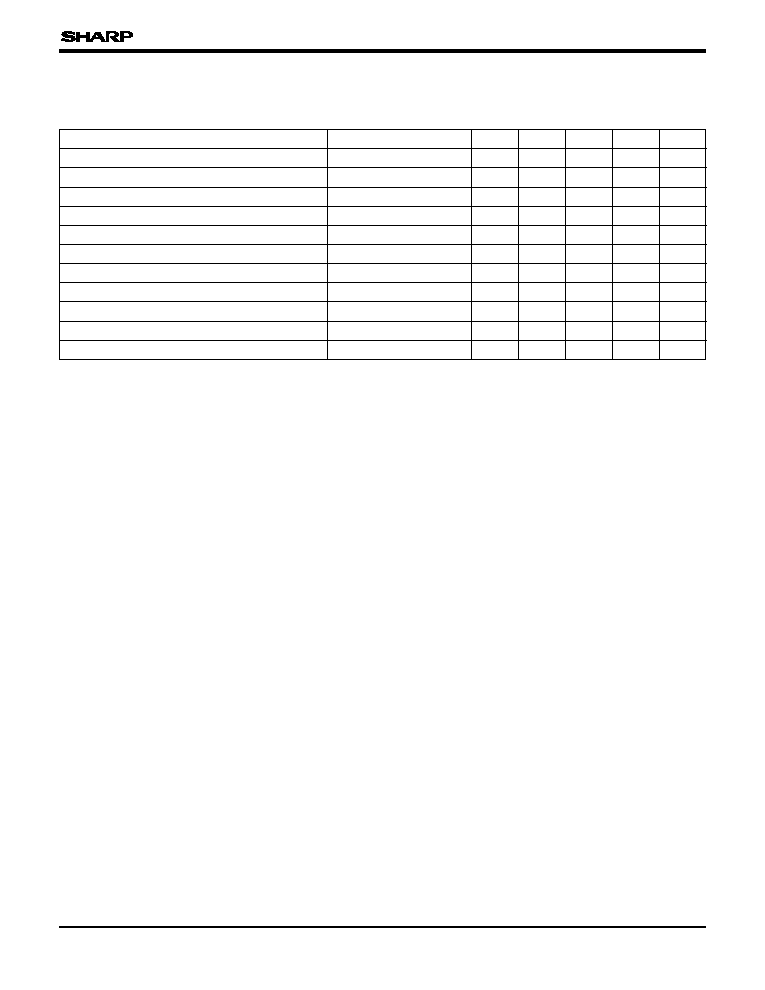
5
LZ2315A/LZ2316AR
CHARACTERISTICS FOR LZ2316AR
(Drive method : Field accumulation)
(T
A
= +25 ∞C, Operating conditions : The typical values specified in "RECOMMENDED OPERATING CONDITIONS".
Color temperature of light source : 3 200 K, IR cut-off filter (CM-500, 1 mmt) is used.)
PARAMETER
SYMBOL
MIN.
TYP.
MAX.
UNIT
NOTE
Standard output voltage
V
O
150
mV
2
Photo response non-uniformity
PRNU
15
%
3
Saturation output voltage
V
SAT
650
mV
4
Dark output voltage
V
DARK
0.5
mV
1, 5
Dark signal non-uniformity
DSNU
0.5
mV
1, 6
Sensitivity
R
700
1 000
mV
7
Smear ratio
SMR
≠110
≠90
dB
8
Image lag
AI
1.0
%
9
Blooming suppression ratio
ABL
1 000
10
Output transistor drain current
I
OD
4.0
8.0
mA
Output impedance
R
O
400
$
NOTES :
∑ Within the recommended operating conditions of V
OD
,
V
OFD
of the internal output satisfies with ABL larger than
1 000 times exposure of the standard exposure conditions,
and V
SAT
larger than 650 mV.
1. T
A
= +60 ∞C
2. The average output voltage under uniform illumination.
The standard exposure conditions are defined as when
Vo is 150 mV.
3. The image area is divided into 10 x 10 segments under
the standard exposure conditions. Each segment's
voltage is the average output voltage of all pixels within
the segment. PRNU is defined by (Vmax ≠ Vmin)/Vo,
where Vmax and Vmin are the maximum and minimum
values of each segment's voltage respectively.
4. The image area is divided into 10 x 10 segments. Each
segment's voltage is the average output voltage of all
pixels within the segment. V
SAT
is the minimum
segment's voltage under 10 times exposure of the
standard exposure conditions.
5. The average output voltage under non-exposure
conditions.
6. The image area is divided into 10 x 10 segments under
non-exposure conditions. DSNU is defined by (Vdmax ≠
Vdmin), where Vdmax and Vdmin are the maximum and
minimum values of each segment's voltage respectively.
7. The average output voltage when a 1000 lux light
source with a 90% reflector is imaged by a lens of F4,
f50 mm.
8. The sensor is exposed only in the central area of V/10
square with a lens at F4, where V is the vertical image
size. SMR is defined by the ratio of the output voltage
detected during the vertical blanking period to the
maximum output voltage in the V/10 square.
9. The sensor is exposed at the exposure level
corresponding to the standard conditions. AI is defined
by the ratio of the output voltage measured at the 1st
field during the non-exposure period to the standard
output voltage.
10. The sensor is exposed only in the central area of V/10
square, where V is the vertical image size. ABL is
defined by the ratio of the exposure at the standard
conditions to the exposure at a point where blooming is
observed.
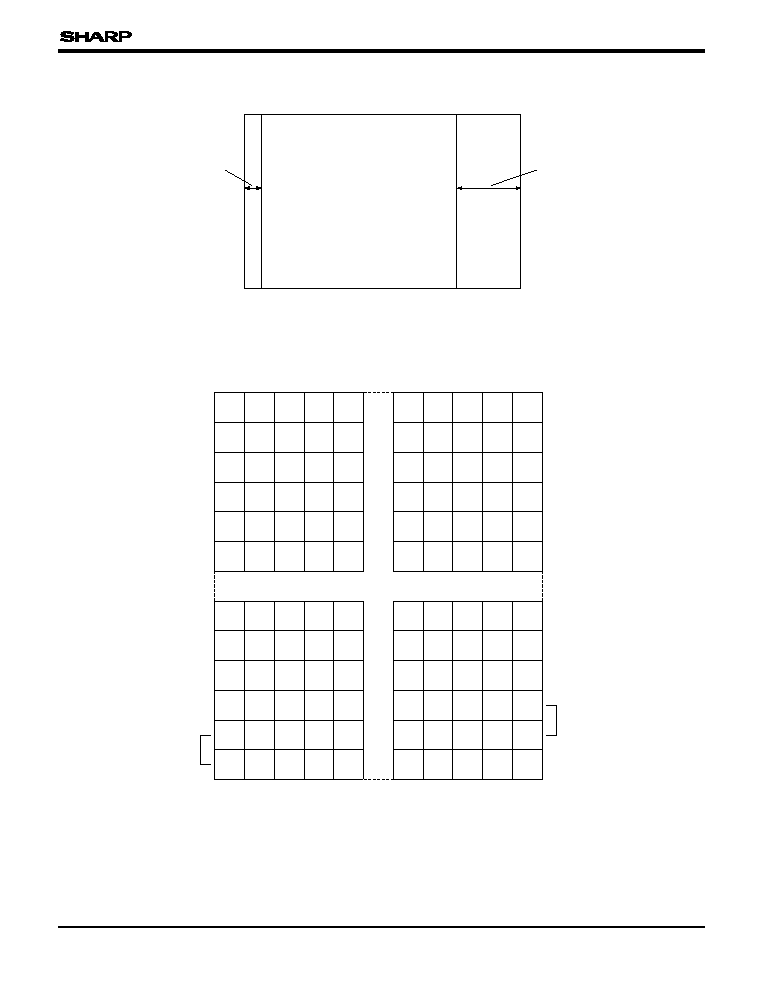
LZ2315A/LZ2316AR
6
PIXEL STRUCTURE
,,
,,
,,
,,
,,
,,
yy
yy
yy
yy
yy
yy
,,,
,,,
,,,
,,,
,,,
,,,
yyy
yyy
yyy
yyy
yyy
yyy
512 (H) x 492 (V)
OPTICAL BLACK
(2 PIXELS)
OPTICAL BLACK
(28 PIXELS)
COLOR FILTER ARRAY (FOR LZ2315A)
Ye
Cy
Ye
Cy
Ye
G
Mg
G
Mg
G
Ye
Cy
Ye
Cy
Ye
Mg
G
Mg
G
Mg
Ye
Cy
Ye
Cy
Ye
G
Mg
G
Mg
G
Cy
Ye
Cy
Ye
Cy
G
Mg
G
Mg
G
Cy
Ye
Cy
Ye
Cy
Mg
G
Mg
G
Mg
Cy
Ye
Cy
Ye
Cy
G
Mg
G
Mg
G
Cy
Ye
Cy
Ye
Cy
Mg
G
Mg
G
Mg
Cy
Ye
Cy
Ye
Cy
G
Mg
G
Mg
G
Cy
Ye
Cy
Ye
Cy
Mg
G
Mg
G
Mg
Ye
Cy
Ye
Cy
Ye
Mg
G
Mg
G
Mg
Ye
Cy
Ye
Cy
Ye
G
Mg
G
Mg
G
Ye
Cy
Ye
Cy
Ye
Mg
G
Mg
G
Mg
(1, 492)
(512, 492)
(1, 1)
(512, 1)
EVEN
field
ODD
field
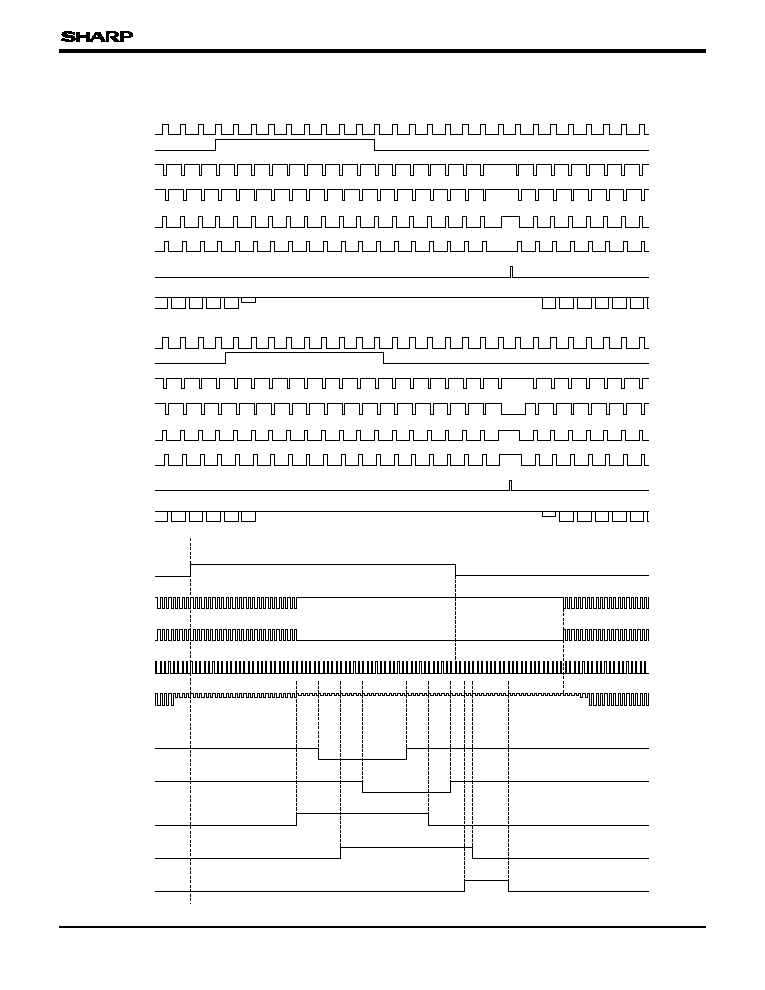
LZ2315A/LZ2316AR
7
TIMING CHART
484
+
485
486
+
487
488
+
489
492
490
+
491
1
+
2
3
+
4
5
+
6
7
+
8
9
+
10
11
+
12
OS
ÿ
TG
ÿ
V4
ÿ
V3
ÿ
V2
ÿ
V1
VD
HD
(ODD FIELD)
VERTICAL TRANSFER TIMING <NORMAL OUTPUT>
483
+
484
485
+
486
487
+
488
489
+
490
491
+
492
2
+
3
1
4
+
5
6
+
7
8
+
9
10
+
11
OS
ÿ
TG
ÿ
V4
ÿ
V3
ÿ
V2
ÿ
V1
VD
HD
(EVEN FIELD)
525 1
10
17
19
263
272
279
282
OS
ÿ
RS
ÿ
H2
ÿ
H1
HD
OB (28)
OUTPUT (512) 1
ÿ
OFD
ÿ
V4
ÿ
V3
ÿ
V2
ÿ
V1
HORIZONTAL TRANSFER TIMING <NORMAL OUTPUT>
606, 1
60
84.5
24
24
49
39
54
29
34
64
62
72
59
512
PRESCAN (4)
OB (2)
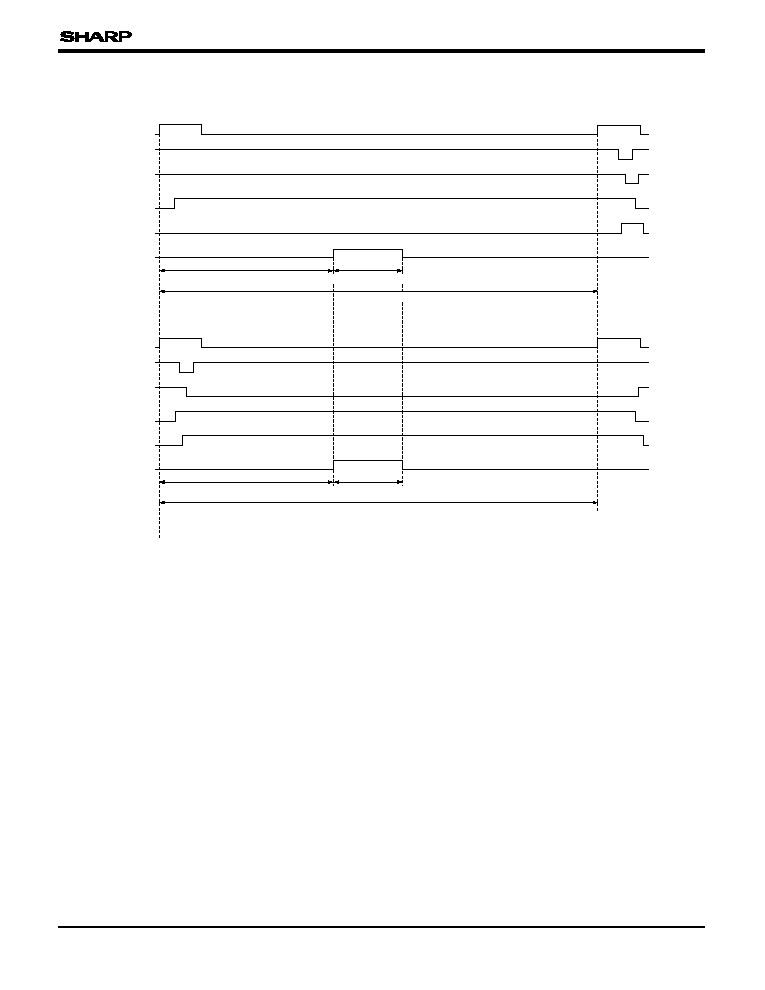
ÿ
V4
ÿ
TG
ÿ
V3
ÿ
V2
ÿ
V1
HD
(ODD FIELD)
(EVEN FIELD)
READOUT TIMING <NORMAL OUTPUT>
ÿ
V4
ÿ
TG
ÿ
V3
ÿ
V2
ÿ
V1
HD
1
24
60
29
39
54
64
34
59
49
60
1
29
39
24
60
54
64
34
338
242
59
49
60
25.36 µs (242 bits)
25.36 µs (242 bits)
63.5 µs (606 bits)
63.5 µs (606 bits)
338
242
10.06 µs (96 bits)
606, 1
606, 1
10.06 µs (96 bits)
LZ2315A/LZ2316AR
8
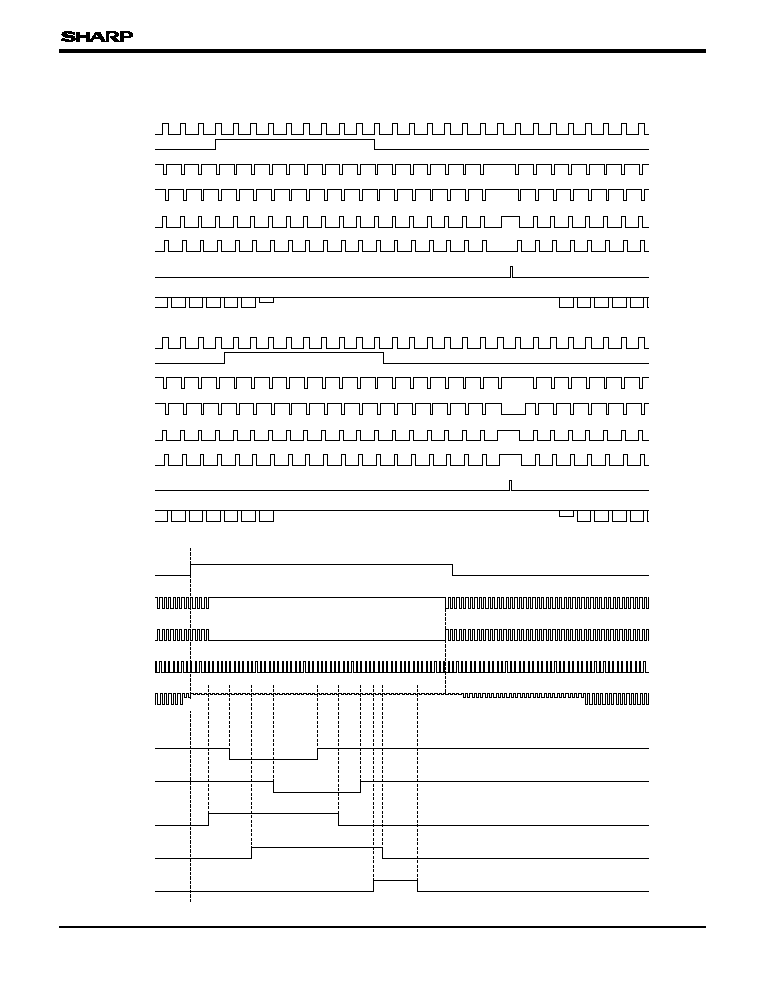
LZ2315A/LZ2316AR
9
482
+
483
484
+
485
486
+
487
490
+
491
492
488
+
489
1
+
2
3
+
4
5
+
6
7
+
8
9
+
10
OS
ÿ
TG
ÿ
V4
ÿ
V3
ÿ
V2
ÿ
V1
VD
HD
(ODD FIELD)
VERTICAL TRANSFER TIMING <MIRROR OUTPUT>
481
+
482
483
+
484
485
+
486
487
+
488
489
+
490
491
+
492
2
+
3
1
4
+
5
6
+
7
8
+
9
OS
ÿ
TG
ÿ
V4
ÿ
V3
ÿ
V2
ÿ
V1
VD
HD
(EVEN FIELD)
525 1
10
17
19
263
272
279
282
OS
ÿ
RS
ÿ
H2
ÿ
H1
HD
OUTPUT (512) 512
ÿ
OFD
ÿ
V4
ÿ
V3
ÿ
V2
ÿ
V1
HORIZONTAL TRANSFER TIMING <MIRROR OUTPUT>
4
58.5
4
29
19
34
9
14
44
42
52
39
1
OB (2)
OB (28)
PRESCAN (4)
606, 1
60
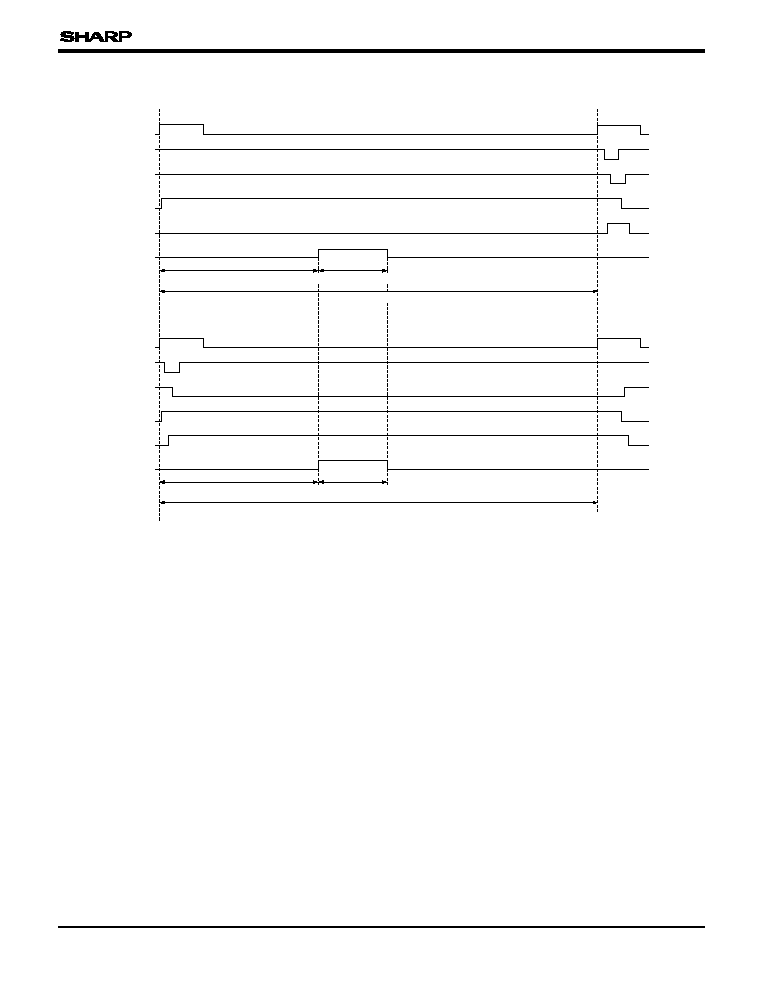
LZ2315A/LZ2316AR
10
ÿ
V4
ÿ
TG
ÿ
V3
ÿ
V2
ÿ
V1
HD
(ODD FIELD)
(EVEN FIELD)
READOUT TIMING <MIRROR OUTPUT>
ÿ
V4
ÿ
TG
ÿ
V3
ÿ
V2
ÿ
V1
HD
1
4
606, 1
606, 1
60
29
39
34
44
14
19
9
60
1
29
19
4
60
34
44
14
318
39
9
60
222
23.27 µs (222 bits)
23.27 µs (222 bits)
63.5 µs (606 bits)
318
222
10.06 µs (96 bits)
63.5 µs (606 bits)
10.06 µs (96 bits)
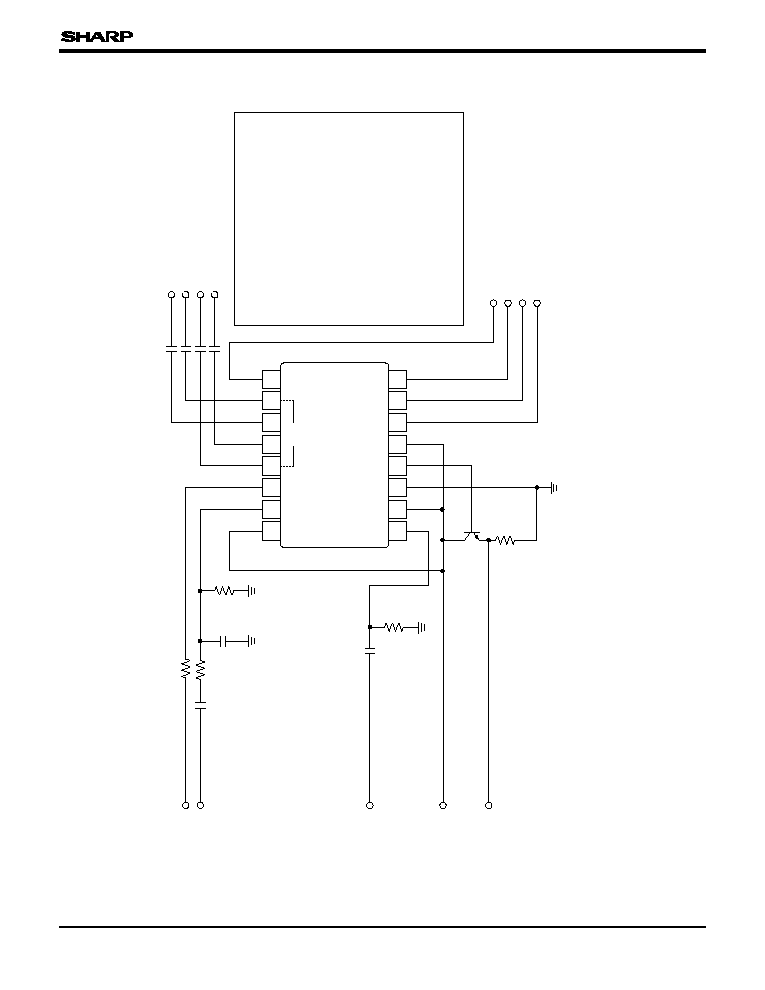
LZ2315A/LZ2316AR
11
SYSTEM CONFIGURATION EXAMPLE
ÿ
H1
ÿ
V1
ÿ
V4
RD
GND
ÿ
V3
OFD
T
1
ÿ
H1B
ÿ
H2
ÿ
H2B
OD
OS
ÿ
TG
ÿ
V2
ÿ
RS
CCD
OUT
2SC4627
1 M$
1 k$
10 $
1 M$
10 $
0.47 µF
0.1 µF
0.1 µF
0.1 µF
0.1 µF
1 000 pF
0.01 µF
9
10
11
12
13
14
(*1)
(*3)
(*2)
(*1)
15
16
8
7
6
5
4
3
2
1
LZ2315A
or
LZ2316AR
V
OD
ÿ
RS
OFDX
TGX
ÿ
H2
ÿ
H1B
ÿ
H1
ÿ
H2B
ÿ
V4
ÿ
V1
ÿ
V3
ÿ
V2
(*1) ÿ
RS
, OFD :
Use the circuit parameter indicated in
this circuit example, and do not connect
to DC voltage directly.
When not using electronic shutter,
connect OFD to GND through a 0.1 µF
capacitor and a 1 M$ resistor.
(*2) ÿ
V1
-ÿ
V4
:
Input the clock through a 0.1 µF
capacitor.
(*3) ÿ
TG
:
Use the circuit parameter indicated in
this circuit example.
∑ Example of drive circuit with LR38580 driver IC.
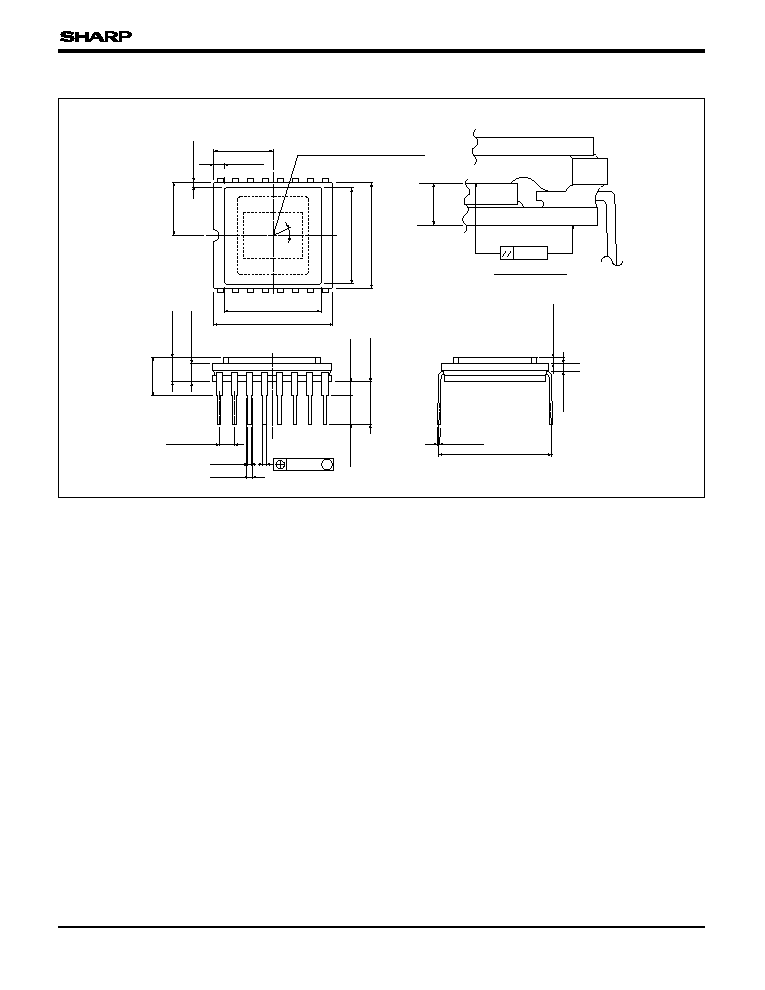
PACKAGES FOR CCD AND CMOS DEVICES
12
PACKAGE
(Unit : mm)
0.04
1.66
±0.10
Package (Cerdip)
Glass Lid
CCD
Cross Section A-A'
1
8
14.00
±0.15
16
9
11.20
±0.10
()
12.40
±0.15
6.20
±0.15
0.60
±0.60
7.00
±0.15
1.40
±0.60
CCD
( : Lid's size)
11.20
±0.10
()
Center of effective imaging area
and center of package
0.25
±0.10
12.70
±0.25
0.80
±0.05
()
1.05
MIN.
0.46
TYP.
0.90
TYP.
2.63
TYP.
5.24
MAX.
3.42
±0.25
1.27
±0.25
3.90
±0.30
2.60
±0.20
P-1.78
TYP.
A'
A
Rotation error of die : ¨ = 1.5∞
MAX.
M
0.25
16 WDIP (WDIP016-N-0500C)
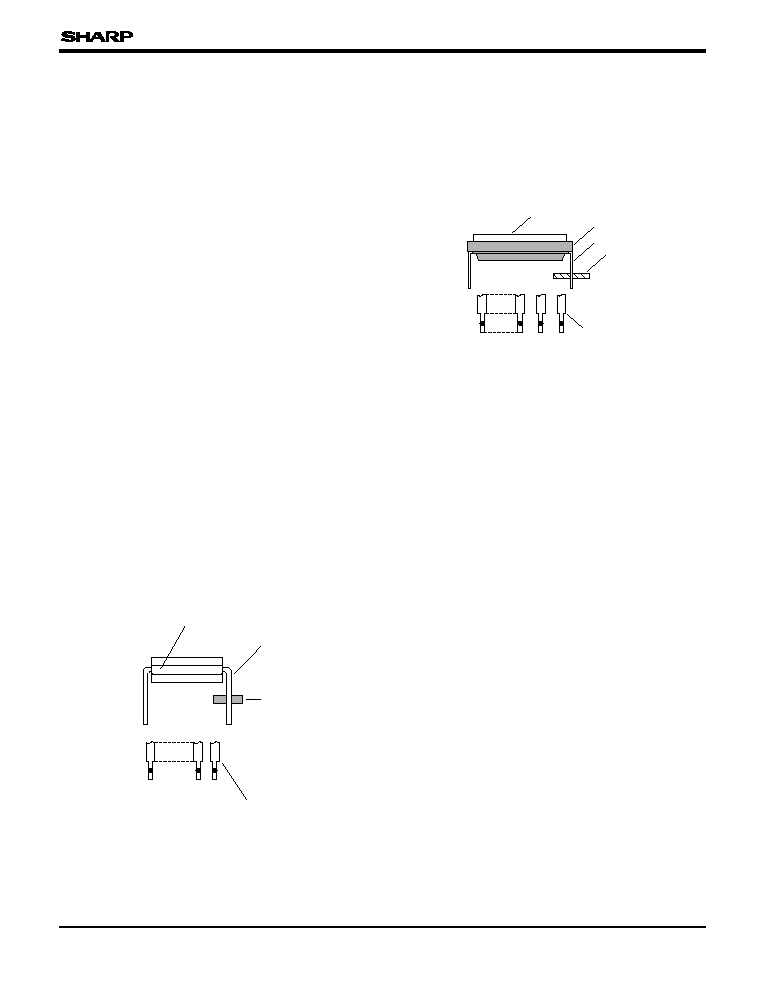
PRECAUTIONS FOR CCD AREA SENSORS
1. Package Breakage
In order to prevent the package from being broken,
observe the following instructions :
1) The CCD is a precise optical component and
the package material is ceramic or plastic.
Therefore,
¯ Take care not to drop the device when
mounting, handling, or transporting.
¯ Avoid giving a shock to the package.
Especially when leads are fixed to the socket
or the circuit board, small shock could break
the package more easily than when the
package isn't fixed.
2) When applying force for mounting the device or
any other purposes, fix the leads between a
joint and a stand-off, so that no stress will be
given to the jointed part of the lead. In addition,
when applying force, do it at a point below the
stand-off part.
(In the case of ceramic packages)
≠ The leads of the package are fixed with low
melting point glass, so stress added to a
lead could cause a crack in the low melting
point glass in the jointed part of the lead.
(In the case of plastic packages)
≠ The leads of the package are fixed with
package body (plastic), so stress added to a
lead could cause a crack in the package
body (plastic) in the jointed part of the lead.
3) When mounting the package on the housing,
be sure that the package is not bent.
≠ If a bent package is forced into place
between a hard plate or the like, the pack-
age may be broken.
4) If any damage or breakage occurs on the sur-
face of the glass cap, its characteristics could
deteriorate.
Therefore,
¯ Do not hit the glass cap.
¯ Do not give a shock large enough to cause
distortion.
¯
Do not scrub or scratch the glass surface.
≠ Even a soft cloth or applicator, if dry, could
cause dust to scratch the glass.
2. Electrostatic Damage
As compared with general MOS-LSI, CCD has
lower ESD. Therefore, take the following anti-static
measures when handling the CCD :
1) Always discharge static electricity by grounding
the human body and the instrument to be used.
To ground the human body, provide resistance
of about 1 M$ between the human body and
the ground to be on the safe side.
2) When directly handling the device with the
fingers, hold the part without leads and do not
touch any lead.
Glass cap
Package
Lead
Fixed
Stand-off
Fixed
Lead
Stand-off
Low melting point glass
13
PRECAUTIONS FOR CCD AREA SENSORS

3) To avoid generating static electricity,
a. do not scrub the glass surface with cloth or
plastic.
b. do not attach any tape or labels.
c. do not clean the glass surface with dust-
cleaning tape.
4) When storing or transporting the device, put it in
a container of conductive material.
3. Dust and Contamination
Dust or contamination on the glass surface could
deteriorate the output characteristics or cause a
scar. In order to minimize dust or contamination on
the glass surface, take the following precautions :
1) Handle the CCD in a clean environment such
as a cleaned booth. (The cleanliness level
should be, if possible, class 1 000 at least.)
2) Do not touch the glass surface with the fingers.
If dust or contamination gets on the glass
surface, the following cleaning method is
recommended :
¯ Dust from static electricity should be blown
off with an ionized air blower. For anti-
electrostatic measures, however, ground all
the leads on the device before blowing off
the dust.
¯
The contamination on the glass surface
should be wiped off with a clean applicator
soaked in Isopropyl alcohol. Wipe slowly and
gently in one direction only.
≠ Frequently replace the applicator and do not
use the same applicator to clean more than
one device.
Note : In most cases, dust and contamination
are unavoidable, even before the device
is first used. It is, therefore, recommended
that the above procedures should be
taken to wipe out dust and contamination
before using the device.
4. Other
1) Soldering should be manually performed within
5 seconds at 350 ∞C maximum at soldering iron.
2) Avoid using or storing the CCD at high tem-
perature or high humidity as it is a precise
optical component. Do not give a mechanical
shock to the CCD.
3) Do not expose the device to strong light. For
the color device, long exposure to strong light
will fade the color of the color filters.
14
PRECAUTIONS FOR CCD AREA SENSORS













